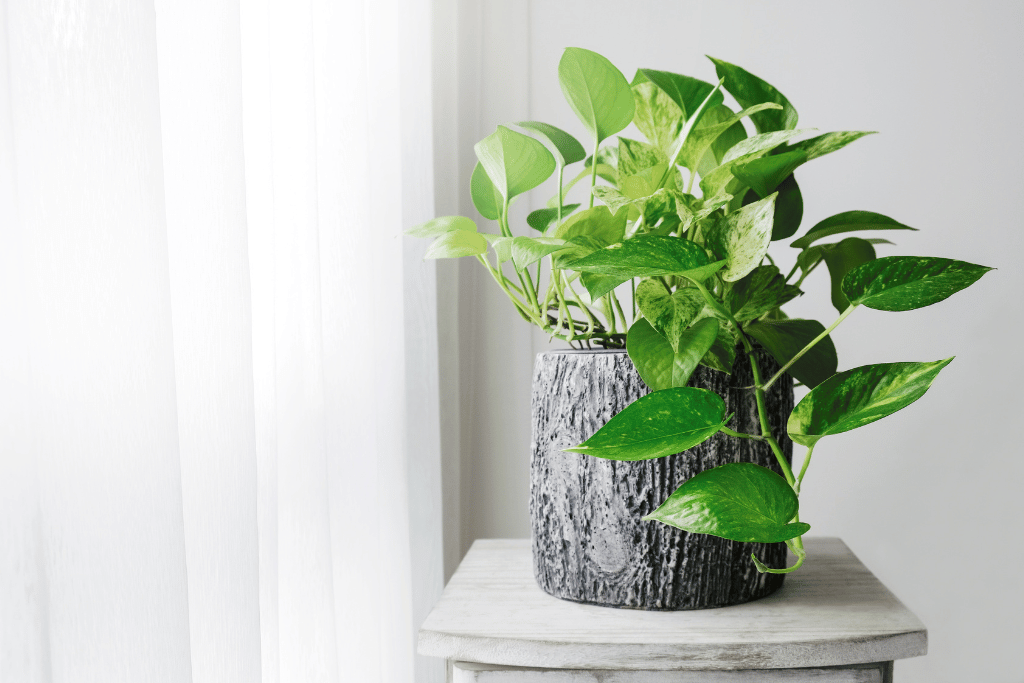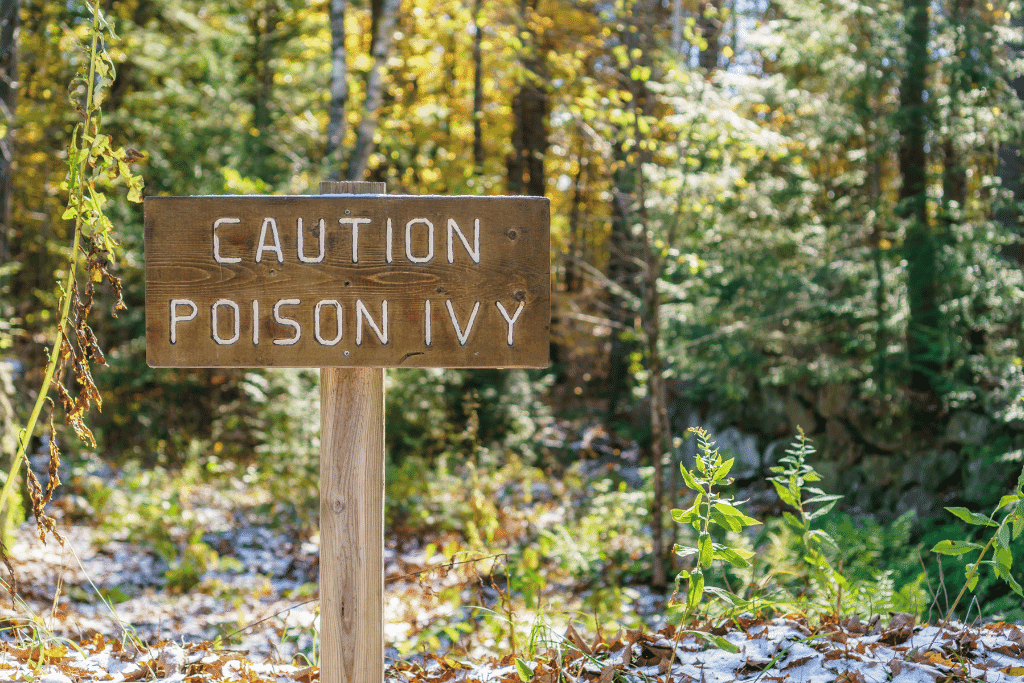
A garden without problems!” said no gardener ever. Within this green sanctuary, there’s always a sneaky troublemaker hiding, ready to disrupt the peace and beauty of your garden. One such troublemaker is the poison ivy!
The plant you don’t want anywhere near you because it’s notorious for causing those irritating rashes. If you’re a green-thumbed gardener or just someone who loves their outdoor space, you’ve probably faced this menace at some point. Now, you’re on a mission to kick poison ivy to the curb without giving your precious plants the boot.
Here’s the real conundrum: how to get rid of poison ivy without killing other plants. So, under the shade of those tricky leaves, we’re here to figure out this puzzle together. We’re gonna spill the beans on how to kill poison ivy without harming other plants.
Let the games begin:
Tips to Spot Poison Ivy

Getting to know your enemy is the first rule of any battle, and the war against poison ivy is no different. I will be shedding light on how to spot poison ivy from a mile away and avoid its unpleasant surprises.
1. Habitat: Where Does Poison Ivy Hang Out?
Poison ivy isn’t picky when it comes to locations. You can find it almost everywhere: in the woods, by the water, on the beach, and even in your own backyard. But it’s not just random; it prefers places with a bit of sunlight and loves to pop up where the land has been messed with, like along trails, on the fringes of fields, and in your landscaping.
2. The Two Faces of Poison Ivy: Eastern vs. Western
Before we dive into the nitty-gritty details, there are two main types of poison ivy in the U.S.: eastern and western. They’re like cousins that look quite similar but have their own turf. Sometimes, they even crossbreed in areas where their territories overlap.
Eastern Poison Ivy: The Climber
Eastern poison ivy is a bit of an acrobat. It tends to crawl and cling to trees, shrubs, walls, and fences, using its tiny rootlets to get a grip. If you see a plant doing some impressive tree-hugging, it’s probably the eastern variety.
Western Poison Ivy: A Ground Creeper
The western counterpart, on the other hand, keeps it low and grows along the ground. It doesn’t fancy climbing trees or structures like its eastern cousin. So, if you spot some three-leafed greenery staying low to the ground, it might be the western variety.
3. Leaves of Three, Let It Be!
Now, let’s talk about the most famous rule in the poison ivy playbook: “Leaves of three, let it be.” This saying has saved countless folks from itchy encounters. Each poison ivy leaf is made up of three smaller leaflets. The one in the middle usually has a longer stem than the two on its sides.
4. Unpredictable Shapes: It’s All About Variety
Here’s a tricky part: poison ivy isn’t always consistent in its appearance. Its leaves can have pointed tips, smooth edges, or serrated teeth. They’re typically twice as long as they are wide, measuring somewhere between 2 to 5 inches. So, don’t expect poison ivy to follow a strict dress code – it can be quite the fashion chameleon.
5. A Seasonal Chameleon: How Poison Ivy Changes Its Look
Like a true show-off, poison ivy keeps changing its appearance through the seasons. It’s like Mother Nature’s version of a fashion makeover. Let’s break it down:
Spring Show-Off: Reddish New Growth
In the spring, poison ivy kicks off with new leaves that show off deep red, mahogany hues. They’ll eventually mellow into a shiny green as they mature. But don’t be fooled by the young ones – their tips might be more rounded at first.
Summer Uniform: Green and Lush
Summer is when most of the leaves go green, but you might spot a couple that keep a reddish tint early in the season. Plus, poison ivy can get ambitious and sprawl all over your turf, weaving itself into the grass and your other plants. So, watch out when you’re out and about in your shorts and tees.
Fall Transformation: Leaves on Fire
Come fall, poison ivy switches to its fiery red, orange, and yellow costumes. They may look pretty, but don’t forget they’re still little troublemakers, ready to give you a nasty rash.
Winter Minimalism: Hairy Vines
Even when it’s too cold for other plants to show off, poison ivy maintains a minimalist vibe. In the winter, you’ll see its hairy vines clinging to tree trunks or walls. These hairs are like tiny grappling hooks that help the plant keep its grip, even without leaves.
Now that you’ve got the lowdown on identifying poison ivy, it’s time to move on to the juicy part: how to get rid of it while keeping your garden friends safe and sound. Let’s dive in!
6. The Look-Alikes: Plants That Look Like Poison Ivy
While spotting poison ivy might seem like a straightforward task, it’s made trickier by a group of botanical impostors. These plants wear the same three-leaf disguise, leading to cases of mistaken identity. Let’s explore these sneaky look-alikes:
#1 – Poison Oak:
A notorious doppelganger of poison ivy, poison oak adds to the confusion. It prefers the western and southeastern United States and generally thrives as a low shrub, which can set it apart from poison ivy’s more vine-like tendencies. Its leaves are usually less pointed, making them somewhat less menacing in appearance.
#2 – Box Elder:
This plant has a clever disguise, switching from three leaves in the spring to five or even seven later, complete with “helicopter” seeds. However, unlike poison ivy, it doesn’t typically have three leaflets year-round.
#3 – Virginia Creeper:
With five leaflets, the Virginia creeper is easy to distinguish from poison ivy once it matures. But in its younger years, it can sometimes mimic poison ivy’s infamous trio of leaves, adding a layer of complexity to the identification game.
7. Berries Tell the Tale
Another reliable way to distinguish poison ivy from its look-alikes is by examining the berries. Poison ivy produces small, white or yellowish berries, a trait that sets it apart. In contrast, the Virginia creeper boasts blue-black berries, while the skunkbush prefers dark red ones.
8. Vines and Shapes: The Versatile Poison Ivy
One of the reasons poison ivy is so difficult to pin down is its shape-shifting abilities. It can appear as a shrub, ground cover, or form dense green vines that climb walls or trees. This adaptability makes it particularly challenging to identify correctly.
So, when you’re exploring urban areas or places that have been disturbed – prime real estate for poison ivy – stay vigilant. If you’re not entirely certain about a plant’s identity, it’s best to play it safe and avoid any contact.
Consider using a plant identification app, or if you’re feeling bold, put on some sturdy garden gloves and take a cutting to your local nursery for an expert opinion. When all else fails, professional poison ivy removal services are just a phone call away, ready to come to your rescue.
With these look-alikes identified, you’ll be better equipped to spot poison ivy, ensuring you take the right precautions when you encounter it in your outdoor space. But the real challenge lies in getting rid of poison ivy without causing harm to your other cherished plants. Let’s move on to the heart of the matter and explore effective methods for tackling poison ivy while safeguarding your green companions.
10 Ways on How to Get Rid of Poison Ivy Without Killing Other Plants
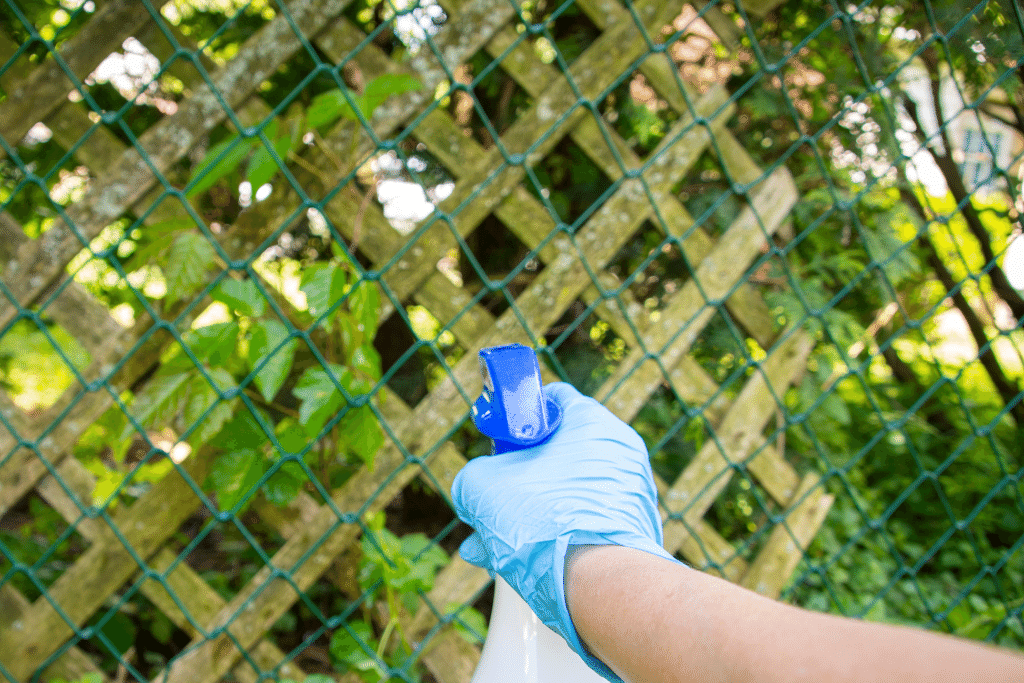
There’s no doubt about the fact that Poison ivy (Toxicodendron radicans) can indeed be a nuisance for many gardeners and outdoor enthusiasts. This resilient plant can cause itchy rashes, discomfort, and even severe allergic reactions in some individuals upon contact.
Therefore, it’s crucial to safely eradicate poison ivy in order to maintain a healthy and enjoyable outdoor space. Here’s how you can get rid of this plant:
1. Manual Removal: The Safest Approach
The most effective method for eliminating poison ivy without harming other plants is manual removal. This approach involves physically uprooting the plant, ensuring that no toxic residue is left behind. Here are the steps to follow:
Gather Essential Tools: Before you begin, make sure you have the necessary tools and personal protective equipment. You will need a garden trowel or shovel, garden shears, long pants, a long-sleeved shirt, heavy-duty gloves, and gumboots. This gear is essential for protecting your skin from contact with the plant.
Choose the Right Weather Conditions: Select a calm, dry day for removal. This minimizes the risk of spreading urushiol, the irritant found in poison ivy, which can cause skin reactions.
Root Removal: To ensure complete eradication, dig 3 to 6 inches deep to remove the plant’s roots. Regrowth can occur if any roots remain in the soil, so thorough removal is crucial.
Proper Disposal: After removing the poison ivy plant, bag the plant material securely. It’s a good practice to double-bag it to prevent accidental exposure. Make sure you dispose of it in a way that adheres to local waste regulations.
Avoid Burning: Never burn poison ivy plants, as the flames can release toxic substances into the air, potentially causing health issues when inhaled. Proper disposal is essential for your safety and the environment.
Regular Inspection: After manual removal, it’s important to regularly inspect the treated area for new growth. If you spot any emerging plants, remove them promptly to prevent the resurgence of poison ivy.
2. Boiling Water: A Non-Toxic Solution
For isolated patches of poison ivy, pouring boiling water on the plant is an effective and non-toxic solution. Here’s what you need to know:
Effectiveness and Caution: Boiling water can effectively kill poison ivy, but it’s not an instant solution. Multiple applications may be necessary, as the plant’s underground roots are resilient.
New Growth: Even after the plant appears to have died back, new growth may occur. Be prepared for additional treatments if necessary.
3. Smothering the Plant
Another effective and environmentally-friendly method is to smother the poison ivy plant. You can achieve this by using heavy cardboard or a plastic tarp. Here’s how to go about it:
Check for Runner Shoots: Poison ivy often spreads through underground roots known as runner shoots. Ensure that you cover these as well to prevent the emergence of new plants.
Alternative Method: Instead of cardboard or a tarp, you can cover the plant with a 12-inch-thick layer of coarse wood chips. Keep in mind that this method may take up to three months to completely kill the poison ivy.
4. Vinegar: A Temporary Solution
Vinegar, with its acetic acid content, is a short-term solution that primarily affects the plant’s top growth, including the stems and leaves. However, it does not eradicate the roots, so regrowth is likely, especially with mature plants.
Here’s what you should consider:
Horticultural Vinegar: Consider using horticultural vinegar, which has higher concentrations of acetic acid for improved effectiveness.
Soil pH Balance: Be cautious about the impact on your soil’s pH balance. Vinegar can temporarily increase soil acidity, which might affect nearby plants.
Wind Precautions: Use vinegar on calm, windless days to prevent it from drifting onto other plants, potentially damaging them.
5. Non-Toxic Homemade Spray
Creating a non-toxic homemade spray can be an effective way to eliminate poison ivy. You’ll need the following ingredients:
- A spray bottle
- 1 gallon of white vinegar
- 8 drops of dishwashing liquid
- 1 cup of salt
Mix these ingredients thoroughly and apply the solution directly to the poison ivy plant, taking care to protect surrounding plants from exposure. The dishwashing liquid helps the solution adhere to the plant’s leaves, ensuring better coverage.
6. Household Remedy: Bleach and Salt
A homemade remedy involving bleach and salt can also be effective for poison ivy removal. Here’s how to prepare and apply this solution:
Ingredients: You will need a spray bottle, 2 cups of bleach, ½ cup of hydrogen peroxide, and ½ cup of salt.
Protection for Other Plants: Before applying the mixture, ensure that surrounding plants are protected from contact with the solution.
Generous Application: Apply the bleach and salt mixture generously to the poison ivy plant. Make sure you saturate the plant thoroughly.
7. Herbicides: A Last Resort
Herbicides containing glyphosate or triclopyr can be effective in eliminating poison ivy but should only be considered as a last resort due to their toxicity. Glyphosate, in particular, is systemic and can be absorbed throughout the plant, including the roots. Here’s how to use herbicides safely:
Choose the Right Day: Spray herbicide on a dry, windless day to minimize the risk of harming desirable plants.
Prune Visible Stems: Before applying the herbicide, prune any visible poison ivy stems. This allows the herbicide to penetrate more effectively.
Disposal and Safety: Carefully dispose of the cuttings and wash your clothes and equipment to avoid any potential contamination. Glyphosate can harm other plants, even in small quantities, so use it sparingly and responsibly.
8. Natural Prevention with Grass Seed
If you prefer a preventive approach, consider planting grass seed to suppress future poison ivy growth. Grass lawns tend to inhibit poison ivy, making this a natural and effective preventive solution. Here’s what you need to know:
Grass Lawns: Planting and maintaining a healthy grass lawn can prevent poison ivy from taking root. The dense growth of grass outcompetes poison ivy and limits its ability to grow.
Regular Maintenance: Keep your lawn well-maintained by mowing and fertilizing to ensure that grass remains dominant.
9. Using Animals to Control Poison Ivy
One innovative approach to controlling poison ivy is to employ animals that naturally feed on this plant. Certain animals, such as goats and deer, are known to graze on poison ivy without experiencing adverse effects. By allowing these animals to graze in areas with a poison ivy infestation, you can significantly reduce the plant’s growth.
Goats: Goats are voracious eaters and have a remarkable ability to consume poison ivy. They can efficiently clear areas infested with this plant. However, it’s important to ensure the safety and well-being of the goats during their work, providing them with proper fencing and supervision.
Deer: Deer are known to browse on poison ivy as part of their natural diet. While relying solely on deer for control may not be as effective as using goats, their presence in your area can help keep poison ivy growth in check.
10. Blocking the Source of Growth
Preventing poison ivy from taking root in the first place is an essential aspect of control. To block the source of growth, consider the following strategies:
Mulch: Apply a thick layer of mulch to areas prone to poison ivy growth. Mulch not only suppresses weeds but also creates a barrier that makes it difficult for poison ivy to establish itself.
Regular Maintenance: Consistent upkeep of your outdoor space can help prevent poison ivy from taking hold. Frequent weeding, mowing, and monitoring for new growth are crucial to blocking the plant’s source of growth.
Barrier Plants: Consider planting barrier plants that can deter poison ivy. Some plants, like English ivy and Virginia creeper, can outcompete poison ivy and help prevent its establishment.
Selective Herbicides: When used preventively, selective herbicides can help control poison ivy by targeting emerging seedlings before they become established. Be cautious with herbicide use and follow label instructions.
Is it Dangerous if You Come into Contact With Poison Ivy?
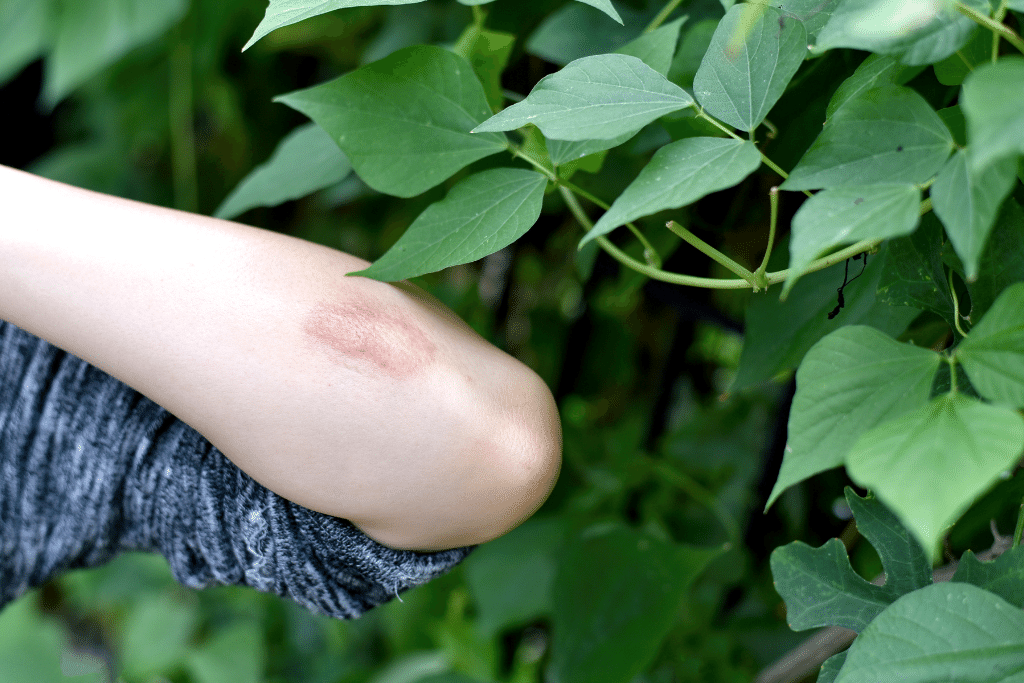
Contact with poison ivy while attempting to remove it is a common concern, and the level of danger associated with such contact depends on several factors, including an individual’s sensitivity, the extent of exposure, and the promptness of response. Here’s a detailed look at the potential dangers of coming into contact with poison ivy while removing it:
Urushiol Oil – The Ingredient that Makes Poison Ivy Dangerous
Poison ivy, like other members of the Toxicodendron family, contains urushiol oil, which is the primary culprit behind the skin reactions. When urushiol comes into contact with the skin, it can lead to a range of symptoms, including redness, itching, swelling, and the formation of blisters. The degree of reaction varies from person to person. While some people may have only mild, localized symptoms, others can experience severe, widespread reactions.
Allergic Sensitivity:
The level of danger largely depends on an individual’s allergic sensitivity to urushiol. Some people may be highly sensitive, reacting even to minimal exposure, while others may have a lower sensitivity, requiring more significant contact to develop a reaction.
Severity of Reaction:
The severity of the reaction can vary widely. In mild cases, contact with poison ivy may result in localized itching and discomfort, which can be managed with over-the-counter remedies and home care. However, in severe cases, the reaction can lead to intense itching, painful blisters, swelling, and in some instances, a systemic reaction requiring medical attention.
Secondary Infection:
Scratching the affected area can break the skin, potentially leading to secondary infections. These infections can worsen the situation and, in some cases, necessitate the use of antibiotics.
Systemic Reactions:
In rare cases, especially for individuals with extreme sensitivity, contact with poison ivy can lead to systemic reactions that affect the entire body. This can include symptoms such as fever, chills, headache, and difficulty breathing. Systemic reactions are a cause for immediate medical attention.
Duration of Symptoms:
Poison ivy rashes typically appear within 12 to 48 hours after contact. The duration of symptoms can vary, with some cases lasting a week or two, while others may persist for several weeks. The intensity of symptoms can also fluctuate throughout this period.
Scarring:
Prolonged or severe reactions can sometimes lead to scarring, particularly if the affected area becomes infected due to scratching.
Sensitization:
Repeated exposure to urushiol can sensitize the body, making future reactions even more severe. It’s important to take precautions when working around poison ivy to avoid sensitization.
Bottomline is, coming into contact with poison ivy is not typically life-threatening, however, it can lead to significant discomfort and potential dangers. Particularly for individuals who are highly sensitive or when reactions become severe.
The key to managing the situation effectively is prompt and appropriate care. If symptoms are mild, over-the-counter remedies and home care can be sufficient. However, in cases of severe reactions, systemic symptoms, or secondary infections, seeking medical attention is crucial.
What to Do if You Accidentally Come into Contact With Poison Ivy While Removing It
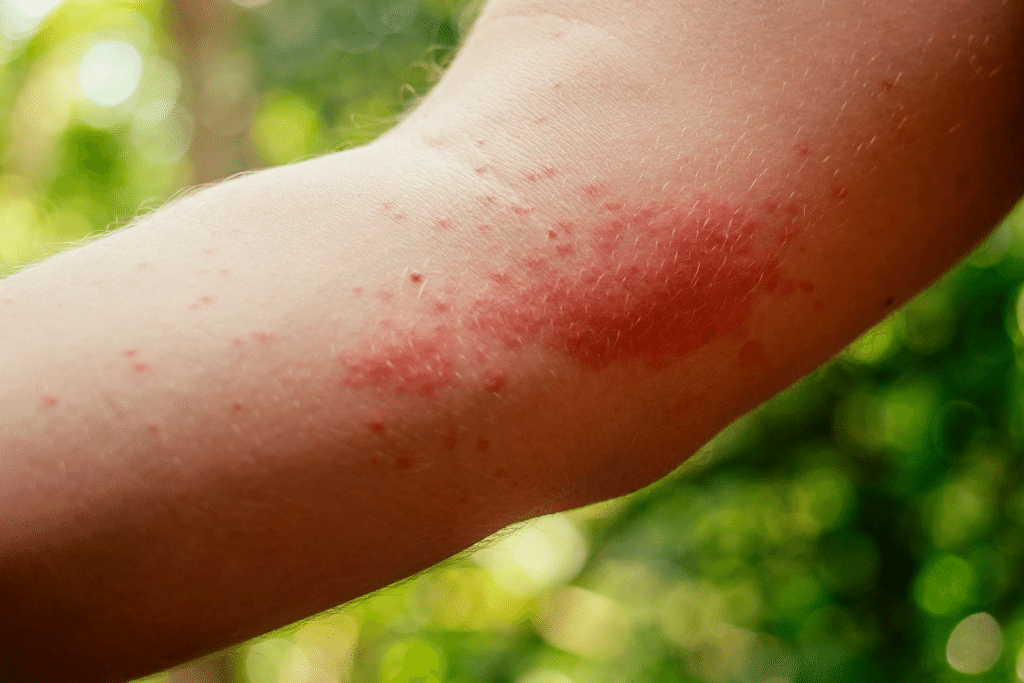
Accidentally coming into contact with poison ivy while attempting to remove it is a common concern, as the plant’s urushiol oil can cause uncomfortable skin reactions. If you find yourself in this situation, it’s essential to take immediate action to minimize the effects and discomfort.
Here’s a step-by-step guide on what to do if you accidentally touch or are exposed to poison ivy while removing it:
Stop the Exposure:
As soon as you realize you’ve touched poison ivy, cease all contact with the plant. This includes any tools or clothing that may have come in contact with the plant’s oils.
Wash the Area:
The sooner you wash the affected area, the better. Use cool water and mild soap to gently cleanse the skin. Avoid hot water, as it can open up the pores, potentially allowing the urushiol to penetrate deeper into the skin.
Use a Soothing Gel:
Apply a soothing gel specifically designed for poison ivy exposure. This over-the-counter product that can help relieve itching and discomfort. Apply it according to the product’s instructions.
Change Clothing:
If your clothing has come in contact with poison ivy, remove it carefully to prevent further spreading of the urushiol oil. Wash the contaminated clothing separately from other laundry.
Wash Tools and Equipment:
If your gardening tools or equipment have touched the plant, thoroughly clean them to remove any urushiol residue. Use soap and water or rubbing alcohol for this purpose.
Prevent Scratching:
It can be challenging, but do your best to resist scratching the affected area. Scratching can break the skin and lead to infection. Consider wearing clean, cool, and breathable clothing to help prevent the urge to scratch.
Cold Compresses:
Applying a cold, damp cloth or compress to the affected area can help reduce itching and inflammation. Make sure the compress is clean to avoid any potential contamination.
Over-the-Counter Remedies:
Consider using over-the-counter remedies such as calamine lotion or hydrocortisone cream. These products can help relieve itching and reduce inflammation.
Oral Antihistamines:
If the itching is severe and affecting your ability to sleep or go about your daily activities, an oral antihistamine like diphenhydramine (Benadryl) may provide relief. Follow the dosing instructions on the packaging or consult a healthcare professional.
Keep the Affected Area Clean:
Continue to keep the affected area clean and avoid scratching. You can wash it with cool water and mild soap several times a day.
Seek Medical Attention:
If the reaction to poison ivy is severe, or if you experience swelling, blisters, or have difficulty breathing, seek immediate medical attention. Severe reactions may require prescription medications such as corticosteroids.
Prevent Future Exposure:
Learn to identify poison ivy and take precautions to prevent future contact when removing or working near it. Wearing protective clothing, including long garden sleeves, gloves, and closed-toe shoes, can significantly reduce the risk.
It’s important to remember that the severity of the reaction to poison ivy can vary from person to person. While some individuals may experience only mild itching and discomfort, others can have a more severe allergic reaction.
Therefore, it’s crucial to take swift action to minimize the effects if you accidentally come into contact with poison ivy while removing it. If in doubt or if the reaction is severe, consult a healthcare professional for appropriate guidance and treatment.
Are There Plants That Can Naturally Repel Poison Ivy?
The notion of plants naturally repelling poison ivy, while a popular belief, lacks firm scientific support. Some people, however, suggest that certain plants might act as a deterrent to poison ivy by creating a protective barrier, potentially minimizing the risk of contact with this troublesome plant.
Jewelweed
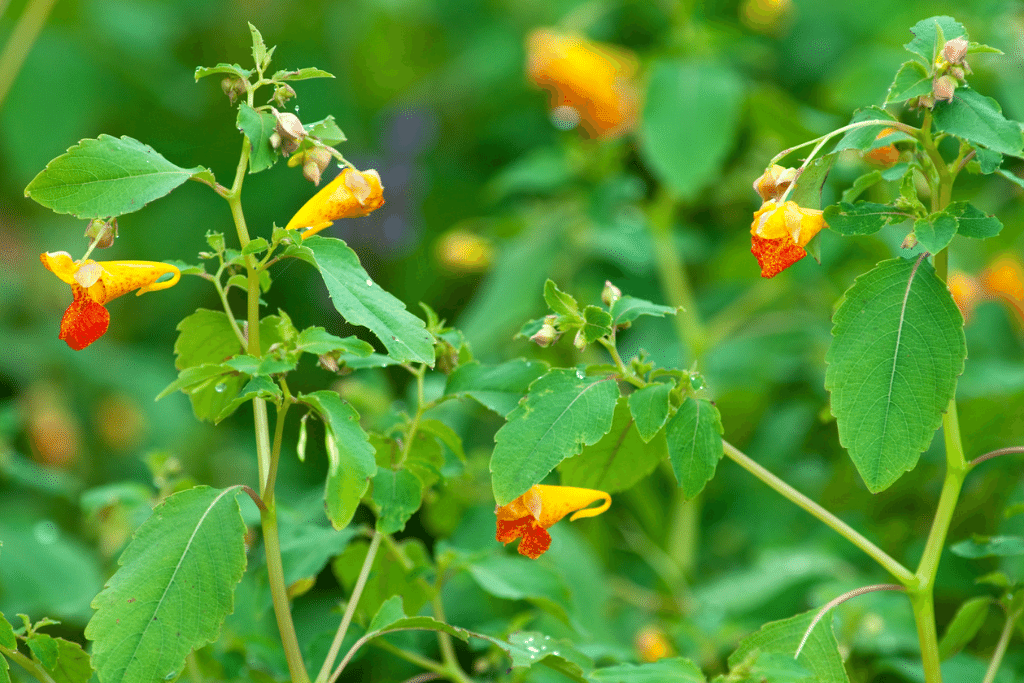
One such plant often mentioned to naturally repel poison ivy is jewelweed. Native to North America, it is frequently found growing in close proximity to poison ivy. It has been a traditional remedy for poison ivy rashes, and some individuals speculate that it may also offer a preventative aspect by thwarting the rash’s development.
Virginia Creeper

Virginia creeper is another plant occasionally recommended for repelling poison ivy. This fast-growing vine possesses the ability to establish a thick ground cover promptly, which may serve as a deterrent to the growth of poison ivy in the area.
In addition to jewelweed and Virginia creeper, several other plants have been suggested for their potential to repel poison ivy, including clematis, wild native grape, native wisteria, mugwort, peppermint, and citronella.
Success is not Guaranteed Though
However, it’s important to recognize that the efficacy of these plants in repelling poison ivy remains largely controversial, with no guarantee of success. When it comes to poison ivy, the most reliable approach is to avoid the plant altogether. In situations where contact with poison ivy is unavoidable, taking precautions such as wearing protective clothing and diligently washing hands with soap and water after potential exposure is advised.
In the event that contact with poison ivy does occur, swift action is essential. Washing the affected area with soap and water as soon as possible can help mitigate the risk of a skin reaction. Applying remedies like calamine lotion or hydrocortisone cream may provide relief from itching and inflammation. If the poison ivy rash is severe, seeking medical attention, including the potential need for prescription medication, may be necessary.
Final Words
This guide on how to get rid of poison ivy without killing other plants will aid you in creating a more enjoyable and worry-free garden experience. Remember to prioritize safety, protect surrounding plants, and adhere to local regulations when disposing of poison ivy. Good luck!
FAQS – How to Get Rid of Poison Ivy Without Killing Other Plants
What is the best way to get rid of poison ivy without harming nearby plants?
The best way to eliminate poison ivy without harming other plants is to manually remove the poison ivy while wearing protective clothing, taking care to avoid damaging surrounding vegetation. You can also use herbicides that are specifically designed for broadleaf plants like poison ivy.
How can I protect other plants while removing poison ivy manually?
To protect other plants, wear gloves, long sleeves, and long pants. Carefully uproot the poison ivy, making sure to get as much of the root system as possible. Be cautious not to spread the oils from the poison ivy to other plants, tools, or clothing.
Is there a specific time of year that’s best for removing poison ivy without harming other plants?
Late spring or early summer is often the best time to remove poison ivy because the plants are actively growing. Avoid late fall, as poison ivy’s oils may be more potent, and it’s easier to accidentally spread them.
What should I do if poison ivy is growing in the midst of other plants that I want to keep?
In this case, it’s essential to be extremely cautious during manual removal. Use a small trowel or shovel to carefully excavate the poison ivy’s roots, making sure not to disturb the surrounding plants. It’s often a slow and meticulous process.
Can I use a barrier to prevent poison ivy from spreading to other plants?
Yes, you can use physical barriers such as landscaping fabric or plastic edging to create a boundary around the poison ivy-infested area. This can help contain its growth and protect other plants.
What precautions should I take when using herbicides near other plants?
When using herbicides near other plants, be sure to shield desirable vegetation with cardboard or plastic, apply the herbicide on calm days to prevent drift, and avoid overspraying. Follow the manufacturer’s instructions to the letter to minimize the impact on non-target plants.



